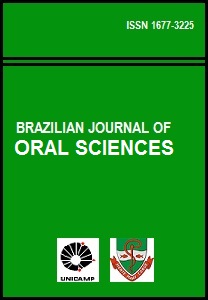Abstract
A total of 120 children, aged 6-8 years, with different socioeconomical status (A, B and C categories) of high, middle and low class, respectively, were selected for a dental examination and data on possible variables for dmft(s) and DMFT(S) were obtained to predict the risk of caries development. Variation on dmft(s)/DMFT(S) was accounted for by the effect of some variables with a socioeconomic base. A representative part of the population in this study, particularly among the lower socioeconomic status group, was considered the highest risk group for developing dental caries. Among the parameters employed to identify such high risk populations only dmft(s) showed statistically significant differences for each socioeconomic status. The data obtained in our studies also showed that the second inferior deciduous molar followed by the first inferior deciduous molar, second molar and first superior molar respectively, were the major teeth showing high scores of dental decay. In the permanent dentition, the lesion is more often observed in the first inferior molar. In the primary dentition the inferior deciduous molars seems to be more susceptible to dental caries, followed by the superior deciduous molars, with the occlusal surface the most harmed by this pathology.References
Alvarez JO, Caceda J, Woolley TW, Carley BN, Caravedo L, Navia JM. A longitudinal study of dental caries in the primary teeth of children who suffered from infant malnutrition. J Dent Res. 1993; 72: 1573-6.
Alvarez JO, Lewis CA, Saman C, Caceda J, Montalvo J, Figueroa ML, Izquierdo J, Caravedo L, Navia JM. Chronic malnutrition dental caries and tooth exfoliation in Peruvian children aged 3- 9 years. Am J Clin Nutr. 1998; 48: 368-72.
Alvarez JO, Navia JM. Nutritional status, tooth eruption, and dental caries. A review. Am J Clin Nutr; 1989; 49: 417-26.
Athanassouli I, Mamai-Homata E, Panagopoulos H, KoletsiKounari H, Apostolopoulos A Dental caries changes between 1982 and 1991 in children aged 6-12 in Athens, Greece. Caries Res. 1994; 28: 378-82.
Bezerra RD. Freqüência de dentes decíduos cariados e hígidos em escolares do nível sócio-econômico alto e baixo, na faixa etária de 3 a 6 anos, na cidade de Salvador. Rev Fac Odont UFBA. 1981; 1: 17-37.
Disney JA, Graves RC, Stamm JW, Bohannan HM, Zack DD. The University of North Carolina caries risk assessment study: further developments in caries risk prediction. Commun Dent Oral Epidemiol. 1992; 20(2): 64-75.
Evans RW, Lo ECM, Darvell BW. Determinants of variation in dental caries experience in primary teeth of Hong Kong children 6-8 years. Commun Dent Oral Epidemiol. 1993; 21:1-3.
Gavazzi JC, Höfling JF, Moreira BW, Peters CF, Usberti AC, Cury JA. Previsores do incremento de cárie em crianças brasileiras. Rev Assoc Paul Cir Dent. 1995; 49(1):40-6.
Glass RL. The first international conference on the declining prevalence of dental caries. J Dent Res 1982; 61:1301-83.
Helm S, Helm T. Correlation between caries experience in primary and permanent dentition in birth-cohorts 1950-70. Scand J Dent Res. 1990; 98: 225-7.
Hunter PB. Risk factors in dental caries. Int Dent J. 1998; 38: 211-7.
Jaafar N, Razak IA. Correlation between caries experience at age 7 and 12: a longitudinal study. J Pedod. 1988; 13(1): 11-6.
Li Y, Navia JM, Bian JY. Caries experience in deciduous dentition of rural chinese children 3-5 years old in relation to the presence or absence of enamel hypoplasia. Caries Res. 1996; 30:8-15.
Lo ECM, Evans RW, Lind OP. Dental caries status and treatment needs of the permanent dentition of 6 - 12-years-olds in Hong Kong. Commun Dent oral Epidemiol. 1990; 18: 9-11.
Morgan MV, Mak KY, Evans RW, Wright FAC. The oral health status of children from Lantan Island. Hong Kong. J Hong Kong Soc Community Med. 1988; 18: 9-17.
Pinto VG. Saúde bucal: Odontologia social e preventiva. 3th ed. São Paulo: Santos; 1989.
Poulsen S, Holm AK. The relation between dental caries in the primary and permanent dentition of the same individual. J Publ Helth Dent. 1980; 40(1): 17-25.
Pugliesi NS, Issao M. Prevalência da perda precoce de dentes decíduos em escolares de São Paulo. Rev Fac Odont S Paulo. 1975; 13(2): 141-8.
Stamm JW, Disney JA, Graves RC, Bohannan HM. The University of North Carolina caries risk assessment. Study I: rationale and content. J publ Helth Dent. 1988; 48(4): 225-32.
Toledo OA. Prevalência de cárie dentária em molares decíduos de pré escolares da cidade de Araraquara. Estudo radiográfico. Rev Assoc Paul Cir Dent 1980; 34(4): 296-301.
The Brazilian Journal of Oral Sciences uses the Creative Commons license (CC), thus preserving the integrity of the articles in an open access environment.

